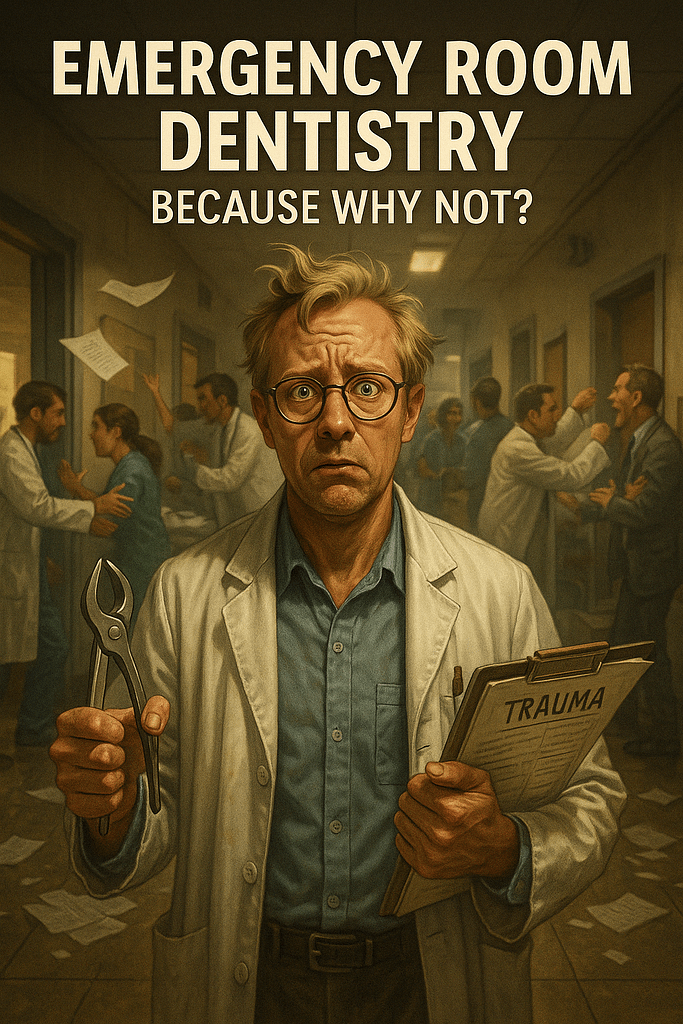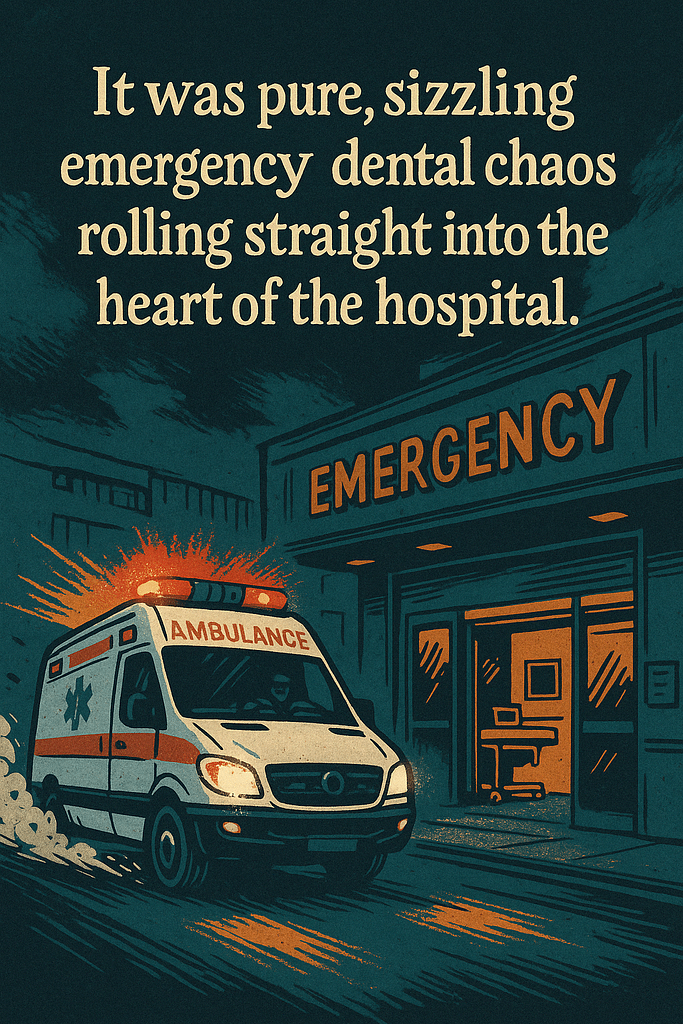The Emergency Room doors slammed open.
Not a trauma victim.
Not a code blue.
A molar.
Fractured.
Bleeding invisible pulp across the linoleum.
Flanking it — two vicious canines, twitching like bodyguards after a failed nightclub shooting.
No chart.
No vitals.
No triage band.
Just pure, unfiltered emergency dental chaos rolling straight into the heart of the hospital.
And before anyone could even wonder can Emergency Room pull teeth,
Cardiology and Nephrology were already circling —
white coats snapping, protocols bristling —
ready to ignite the dumbest, bloodiest paperwork war the trauma bay had ever seen.

Table of Contents
There were no trauma alerts that day.
No cardiac arrests.
No helicopter calls inbound.
Just a cracked molar —
half-dead, half-furious —
dragging an entire Emergency Room into madness.
Can emergency room pull teeth?
Technically, yes.
Should they?
Probably not when Cardiology and Nephrology are fighting over bloodwork protocols like it’s a coronary intervention.
Somewhere between diuresis orders and INR calculations,
the hospital stopped functioning like a hospital.
It became a warped battlefield —
where tooth extraction collided with critical care egos,
and nobody — not the molar, not the canines, not even the gods of Emergency Medicine —
could reverse the inevitable crash.
Think You’re Done? Wrong.
Since you’re already too far gone, you might as well suffer through more:
- Is This a Sarcastic Coffee Mug or a Cry for Help? (Yes.)
- Being On Call: One Panicking Intern Later
- Bring Your Kid to Work, They Said. (It’ll Be Fun, They Said.)
- Psych Consult Incoming: It’s Me. I’m the Consult.
Brace yourself. It’s only downhill from here.
Arrival of the Molar
The overhead fluorescent lights buzzed like dying insects.
Triage stood frozen —
half-coffee, half-panic —
as the shattered molar crossed the threshold of the Emergency Room.
No human being accompanied it.
No frantic parent.
No ambulance crew.
Just the molar, dragging its fractured dignity across the scuffed tile,
escorted by two twitching canines radiating the quiet, unstable energy of seasoned ER veterans.
Behind the desk, a nurse glanced up, blinked twice, and immediately pretended not to see anything.
The trauma tech quietly slid the crash cart two inches closer to the door —
just in case.
Because even if nobody dared say it out loud yet,
one brutal question already hung in the electrified air:
can emergency room pull teeth
— and if yes,
who the hell was about to be responsible for it?
Nephrology leaned against a wall, sipping bitter coffee, already calculating fluid shifts in their mind.
Cardiology flipped through phantom labs, muttering about anticoagulation protocols.
ICU peeked over a ventilator, made eye contact with nobody, and backed into the shadows.
Psychiatry wordlessly pulled out a well-worn bottle of benzodiazepines and took inventory.
It didn’t matter if the molar had no airway, no Glasgow score, no pulses to chart.
It had entered the system.
The wheels of the unholy clockwork of protocol had already started grinding —
and now somebody was about to try extracting something they couldn’t even triage properly.
The molar waited.
The canines twitched.
The first shot hadn’t been fired yet.
But everyone could smell the blood in the air.

Cardiology and Nephrology Clash
The molar sat there.
Pulsing.
Radiating defiance.
The canines twitched, low growls rumbling in their throats,
but even they seemed hesitant to wade into the battlefield now forming around them.
It started quietly —
as all wars do.
A clipped question.
A sharp glance.
Cardiology was first to strike.
“Before anyone touches that molar, I want a full INR, complete blood count, and a cardiac clearance.”
Nephrology snorted, arms folded like a sniper waiting for the kill.
“Cardiac clearance? It’s a molar extraction, not a triple bypass.”
Cardiology’s pen tapped against the trauma checklist with machine-gun rhythm.
“Patient’s — I mean, molar’s — bleeding risk is unknown. Standard precautions apply.”
Nephrology stepped forward, eyes cold.
“Fluid balance must be strictly maintained. No unnecessary boluses. No spontaneous hypotension. We manage this by the book.”
ICU ducked behind a portable vent and made themselves very busy documenting absolutely nothing.
Psychiatry took a long sip of black coffee and wrote “Group delusion, onset acute” in the margins of their notepad.
Somewhere between an imaginary cath lab referral
and a proposed nephrology consult for “dental-induced hyponatremia,”
the battle lines were drawn.
The molar remained motionless.
A tiny, defiant testament to the Emergency Room’s ability to implode under its own bureaucratic weight.
The canines circled once,
then lay down beside it —
veterans now, waiting for the inevitable collapse.
And still, floating through the trauma bay like the whisper of a death curse:
can emergency room pull teeth
echoed without mercy.

Can Emergency Room Pull Teeth… or Only Common Sense
The molar sat motionless on the gurney,
cracked, gleaming under the fluorescent buzz,
surrounded by the collapse of medical reason.
Cardiology and Nephrology had abandoned civility hours ago.
“We need a full coag panel before anyone lays a gloved finger on it!” Cardiology barked, slamming a clipboard onto a med cart.
“You’re delaying extraction over an INR of 1.4?!” Nephrology fired back, waving a printed creatinine clearance report like a battle flag.
“Meanwhile, this molar is tipping into acute azotemia from your endless consults!”“Creatinine clearance is irrelevant until you control the bleeding risk!” Cardiology snapped.
“You want spontaneous retrograde embolization from a molar extraction? Be my guest.”
The trauma bay dissolved into procedural warfare.
The portable ultrasound beeped, abandoned mid-scan.
Someone ordered a troponin “just in case” — no one was sure for who.
The crash cart stood open, a lonely external defibrillator blinking ominously.
ICU wheeled a transport vent into the hallway, muttering about preoxygenation for “anticipated airway compromise during dental egress.”
Psych was filling out a baker act form — on themselves.
An Orthopedic attending leaned casually against a supply cart,
whispering to the scrub tech:
“Fifty bucks says Nephrology goes for a femoral central line before Cardiology finishes their patient note.”
The molar gleamed beneath the overhead lights.
Silent.
Judging.
By the time the cath lab got involved —
arguing that extraction might cause myocardial strain and urgent coronary angio should be considered prophylactically —
the canines had simply laid down at the foot of the gurney,
their job here done.
Two witnesses to a medical collapse so total,
even the gods of emergency medicine had probably facepalmed and walked away.
And somewhere — maybe overhead, maybe inside the cracked, exhausted skulls of everyone in the room —
one question roared louder than the trauma alert paging in the background:
can emergency room pull teeth
The answer was now irrelevant.
Reality itself had already hemorrhaged out onto the trauma bay floor.
Fluid Overload and the Fall of Sanity
As the battle raged on,
someone — nobody knew who — noted that the molar was starting to look “edematous.”
Nephrology seized the opportunity like a lion sinking teeth into a wounded gazelle.
“Diuretics. Stat. If we don’t manage fluid overload, we risk molar compartment syndrome.”
Cardiology exploded.
“You’ll tank perfusion pressure and cause ischemic necrosis!
You want a dead molar on your conscience?”
Nephrology shot back, brandishing a laminated copy of nephrology consensus.
“Better an over-diuresed molar than a pulmonary edematous one requiring intubation!”
ICU made the sign of the cross and quietly turned up the ventilator settings.
Someone wheeled over a Furosemide drip.
Someone else started charting “acute decompensated molar failure” into the hospital charting system.
The crash cart defibrillator beeped sympathetically.
And the molar — bloated, cracked, defiant —
became the center of a turf war so profound,
it threatened to rewrite the very definition of critical care itself.

Acute Dental Failure
It was bound to happen.
After three rounds of protocol warfare,
six liters of charting,
and a trauma bay soaked in bureaucratic fallout,
the molar finally cracked — literally and figuratively.
The monitors beeped.
The canines whimpered.
Somewhere deep inside the cracked enamel,
the first whispers of ARDS began.
A nurse called it first.
“Sats dropping… 84%. Respiratory distress.”
Someone slammed the Code Blue button so hard the panel cracked.
The crash cart clattered toward the gurney.
And in that instant —
decades of academic rivalry, departmental politics, and passive-aggressive emails —
vanished.
Cardiology and Nephrology locked eyes across the battlefield.
Without a word,
they moved.
One started bagging.
The other drew up epinephrine.
Orders flew, hands moved, suction roared, fluids bolused, drips hung.
For the first time that night, they weren’t fighting each other.
They were fighting for the molar.
It wasn’t enough.
The final EKG strip fluttered out across the trauma bay like a white flag.
Flatline.
No pulse.
Time of death called — 03:47.
Silence blanketed the room.
Someone slowly zipped up a tiny, absurd body bag —
small enough to fit a single shattered tooth and two exhausted canines.
Later, Cardiology and Nephrology sat together in the break room,
drinking burnt hospital coffee in silence.
No jokes.
No blame.
No victory.
Just two soldiers
who had survived the worst dental extraction the Emergency Room had ever seen.
Enemies in Protocol, Brothers in Code Blue
There are no medals awarded for surviving nights like this.
No chart notes filed.
No guidelines for managing the chaos when a simple tooth extraction emergency spirals into a full-scale protocol war.
Just two departments,
two cups of burnt coffee,
and the shared understanding that sometimes, in the emergency room chaos,
your worst enemy becomes your last lifeline.
And sometimes,
even when you fight together,
you lose —
but you survive the night anyway.
Somewhere between blood gases, creatinine clearances, and cracked enamel,
we all learned the same brutal truth:
Can emergency room pull teeth?
Yes.
But maybe it costs more than it saves.

If you’ve ever fought to hold the line between protocol and madness —
if you’ve ever pulled together in the wreckage when survival was the only goal —
then you already know:
This is healthcare.
This is survival.
This is PropofLOL.
Follow us for more dark tales from the frontlines of emergency room chaos.
Because if you’re out there fighting,
you deserve a place that speaks your language.
Still Here? Brave Enough? Prove It.
If you survived this mess with at least 10% brain function, it’s time to join us where sarcasm never sleeps:
Because regular therapy was too expensive.
